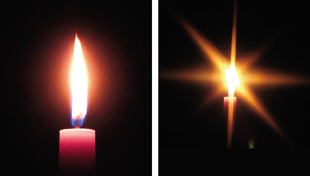Hack 34 Starlight Effects for Candles and Lights
| < Day Day Up > |
Hack 34 Starlight Effects for Candles and Lights Add extra sparkle to your candle and chandelier images by using an inexpensive starlight filter. You can even make your own, if you don't mind scratching a little glass . Candlelit rooms convey a romantic or sentimental mood for your images. All you have to do is steady the camera, trip the shutter, and play from there. The thing with candles, however, is that the light they cast on your subject is often more interesting than the candles themselves . After all, how compelling is a little flame of light? You can add a little oomph to these images by using a star-effect filter, which takes a normal candle flame and turns it into a blazing star, as illustrated in Figure 3-7. Figure 3-7. Candle flame without and with a star filter This little bit of photographic trickery is accomplished by tiny etches in the glass that distort the light. If your camera accepts filters, you can pony up US$25 and start to play right away. One brand of creative filters you might want to take a look at is the Cokin System (http://cokinusa.com), which has star effects, gradual density, and special-effect filters. Cokin has adapters for every type of camera and lens, and it even has a special mount for cameras that don't even have filter rings, such as your digital point and shoot. I've played with the Cokin Star Effect #056, A Version, and have had good success, even on a Canon Digital Elph S400, which doesn't have a filter ring. Figure 3-8 shows how this rig looks. Figure 3-8. Cokin filter attached to a Canon S400 You can also make your own star effects by taking an old UV or skylight filter and etching it with a glass cutter . I recommend you use a crosshatch pattern for your etching. This of course provides you with the opportunity to create unexpected results. 3.7.1 Shooting TechniqueI tend to like the effect of these filters when the light source is smaller, such as the Christmas lights in Figure 3-9. I've noticed quite an improvement after I trim the candle wick, thereby reducing the size of the flame. Points of light produce sharp rays of light, emanating from the source. Larger light sources, such as a light bulb or untrimmed candle wick, produce softer, less detailed effects. Chandeliers can be quite impressive too. Figure 3-9. Small Christmas lights with star filter I've had the best luck mounting the camera on a tripod and using the self-timer to trip the shutter. This helps me avoid the blurring effects of camera shake. Usually, I find that if I use -1 or -2 on the Exposure Compensation dial for close-up shots, I get better rays of light. Experiment until you get the effect you want. Rows of candles shot with a star filter can be impressive. The room is transformed into a magical place, part of some other realitynot bad for an old UV filter with a few etched scratches in it! |
| < Day Day Up > |
EAN: 2147483647
Pages: 161
- Chapter III Two Models of Online Patronage: Why Do Consumers Shop on the Internet?
- Chapter IV How Consumers Think About Interactive Aspects of Web Advertising
- Chapter X Converting Browsers to Buyers: Key Considerations in Designing Business-to-Consumer Web Sites
- Chapter XI User Satisfaction with Web Portals: An Empirical Study
- Chapter XVI Turning Web Surfers into Loyal Customers: Cognitive Lock-In Through Interface Design and Web Site Usability